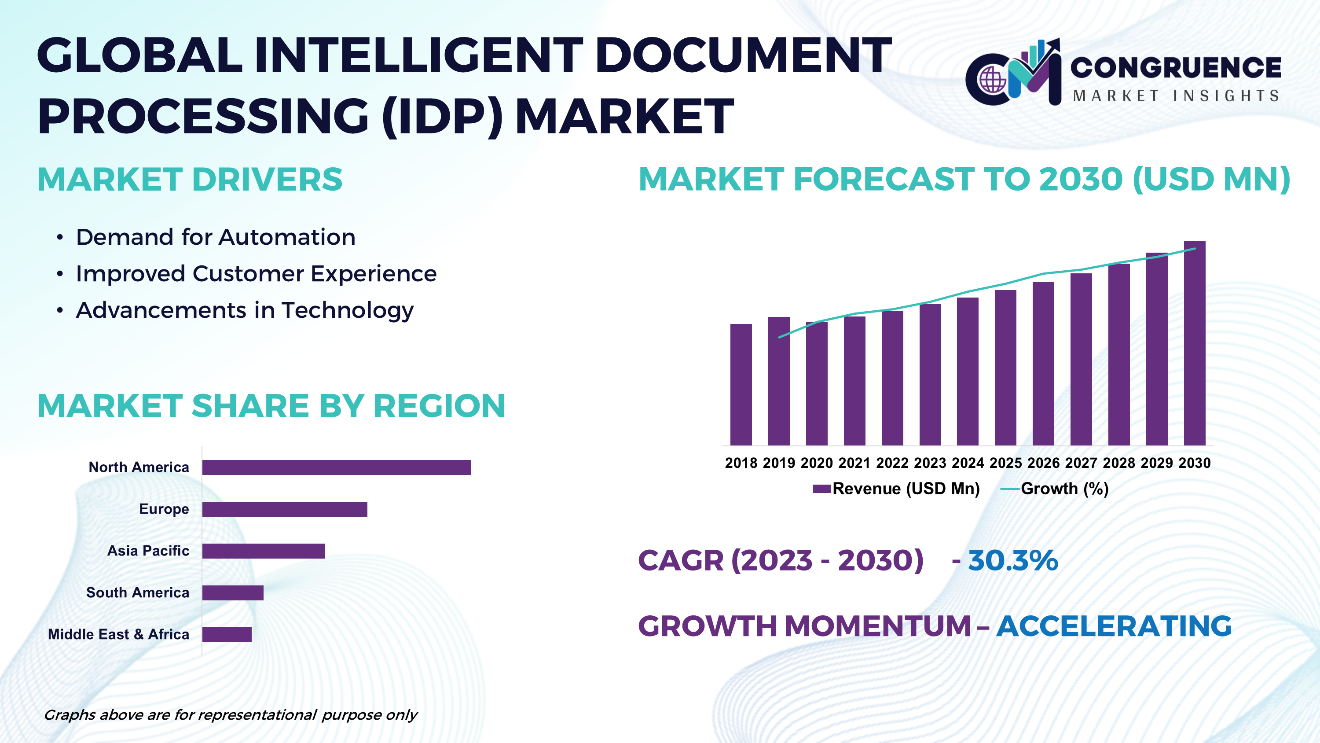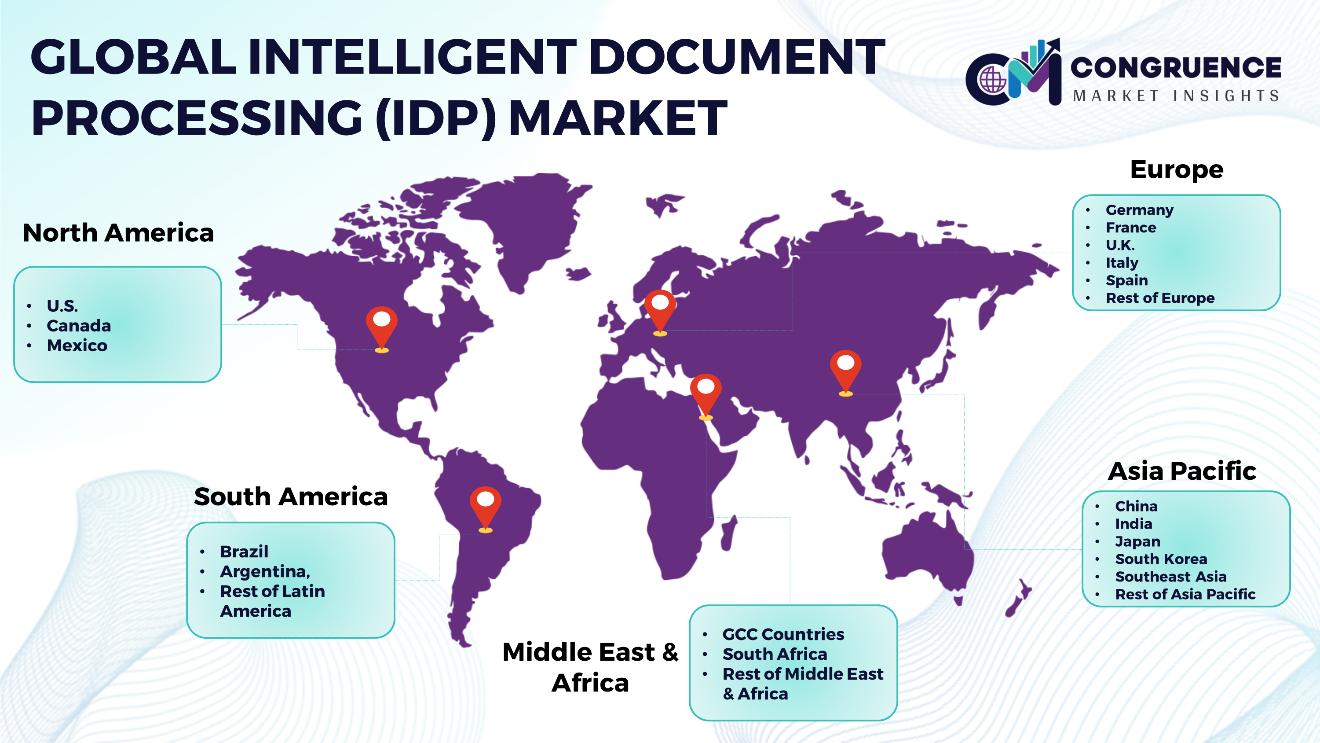Reports
The Global Intelligent Document Processing Market is expected to expand at a CAGR of 30.3% between 2023 and 2030. Intelligent Document Processing (IDP) has swiftly entered the market, propelled by the imperative for streamlined document management. Technological advancements have transformed IDP, with breakthroughs in artificial intelligence (AI), natural language processing (NLP), and machine learning (ML) algorithms enhancing document extraction, classification, and data validation. The transition to Industry 4.0 has further accelerated IDP adoption, as automation, connectivity, and data analytics integration enable real-time document processing and decision-making. The advent of 5G technology has expedited data transmission and connectivity, amplifying the efficiency and scalability of IDP solutions. The IDP market is diverse, with numerous vendors offering specialized solutions tailored to specific industries and applications. Competition among key players centers on features, scalability, and integration capabilities, while strategic partnerships and acquisitions drive market evolution and innovation within the dynamic IDP landscape.

Intelligent Document Processing Market Major Driving Forces
Demand for Automation: Growing needs to automate document-centric processes across industries fuel the adoption of IDP solutions, enhancing workflow efficiency and reducing manual errors.
Improved Customer Experience: IDP enables faster document processing and response times, enhancing customer satisfaction and loyalty by streamlining document-driven interactions and service delivery.
Advancements in Technology: Continuous developments in artificial intelligence (AI), machine learning (ML), and natural language processing (NLP) technologies enhance IDP systems' capabilities, enabling more precise document extraction, classification, and analysis.
Intelligent Document Processing Market Key Opportunities
Vertical Integration: The potential for integrating IDP solutions across various industries, such as healthcare, finance, and legal, to meet specific document processing requirements and regulatory standards unique to each sector.
Advanced AI Capabilities: Opportunities lie in the development of sophisticated AI functionalities, such as deep learning and cognitive computing, to augment IDP systems' accuracy, efficiency, and scalability in handling diverse document types and data formats.
Cloud-Based Solutions: There is a prospect for delivering cloud-based IDP solutions to offer scalability, flexibility, and cost efficiency, allowing seamless integration with existing IT infrastructures and facilitating remote access and collaboration.
Mobile Integration: Exploring the integration of IDP solutions with mobile platforms and applications to enable mobile document processing, enhancing user productivity and convenience, particularly in field-based operations and remote work settings.
Process Automation: The opportunity exists to broaden IDP capabilities for automating end-to-end document-centric processes, including document routing, approval workflows, and data extraction, to enhance operational efficiency and minimize manual intervention.
Enhanced Security Features: Incorporating advanced security measures, such as encryption, access controls, and audit trails, to ensure data confidentiality, integrity, and compliance with data protection regulations, thereby fostering trust and adoption of IDP solutions.
Intelligent Document Processing Market Key Trends
· Advanced AI Integration: Increasing use of advanced artificial intelligence (AI) techniques like machine learning and natural language processing to improve document understanding and data extraction accuracy.
· Cloud-Based Solutions: Rising adoption of cloud-based IDP solutions, offering scalability, flexibility, and cost-effectiveness while facilitating seamless integration with other cloud services.
· Focus on Data Security and Privacy: Heightened emphasis on implementing robust data security measures, including encryption and access controls, to ensure compliance with regulatory standards and protect sensitive information.
· Industry-Specific Solutions: Development of tailored IDP solutions designed to meet the unique document processing needs and regulatory requirements of different sectors such as healthcare, finance, legal, and government.
· Mobile and Remote Access: Increasing demand for mobile-friendly and remote-accessible IDP solutions to support flexible work arrangements and enable document processing on-the-go.
· Robotic Process Automation (RPA) Integration: Integration of IDP with RPA platforms to automate document-centric processes, enhancing operational efficiency and reducing manual intervention.
· Enhanced User Experience: Focus on improving user experience through intuitive interfaces and interactive features to empower users in document processing tasks.
· Integration with Enterprise Systems: Seamless integration of IDP solutions with existing enterprise systems like ERP and CRM platforms to streamline document workflows and enhance data interoperability.

Market Competition Landscape
In the landscape of IDP solutions, fierce competition among providers is evident. Rivals compete to establish market supremacy by emphasizing product innovation, scalability, and integration capabilities. They seek to distinguish themselves through cutting-edge AI algorithms, cloud-based solutions, and industry-specific offerings. Market consolidation is propelled by strategic partnerships and acquisitions, with regulatory compliance and data security playing pivotal roles in building customer trust and driving adoption.
Key players in the global Intelligent Document Processing market implement various organic and inorganic strategies to strengthen and improve their market positioning. Prominent players in the market include:
· ABBYY
· UiPath
· Automation Anywhere, Inc.
· IBM Corporation
· Lexmark International, Inc.
· AntWorks
· Parascript, LLC
· Tungsten Automation Corporation
· Rossum
· Infrrd Inc.
· Capgemini
· Celaton
· BIS, Inc.
· DocuWare Europe GmbH
· M-Files
· Esker
· Fortra, LLC
· Ocrolus
|
Report Attribute/Metric |
Details |
|
Base Year |
2022 |
|
Forecast Period |
2023 – 2030 |
|
Historical Data |
2018 to 2022 |
|
Forecast Unit |
Value (US$ Mn) |
|
Key Report Deliverable |
Revenue Forecast, Growth Trends, Market Dynamics, Segmental Overview, Regional and Country-wise Analysis, Competition Landscape |
|
Segments Covered |
· By Offering (Software, and Service) · By Deployment Model (On-Premises, and Cloud-Based) · By Technology (Optical Character Recognition (OCR), Natural Language Processing (NLP), Machine Learning (ML), and Robotic Process Automation (RPA)) · By Application (Purchase Orders Management, Contract Management, Invoice Processing, Legal Document Processing, and Others) · End User (Healthcare, Retail and E-Commerce, BFSI, Government, IT and Telecom, and Others) |
|
Geographies Covered |
North America: U.S., Canada and Mexico Europe: Germany, France, U.K., Italy, Spain, and Rest of Europe Asia Pacific: China, India, Japan, South Korea, Southeast Asia, and Rest of Asia Pacific South America: Brazil, Argentina, and Rest of Latin America Middle East & Africa: GCC Countries, South Africa, and Rest of Middle East & Africa |
|
Key Players Analyzed |
ABBYY, UiPath, Automation Anywhere, Inc., IBM Corporation, Lexmark International, Inc., AntWorks, Parascript, LLC, Tungsten Automation Corporation, Rossum, Infrrd Inc., Capgemini, Celaton, BIS, Inc., DocuWare Europe GmbH, M-Files, Esker, Fortra, LLC, Ocrolus |
|
Customization & Pricing |
Available on Request (10% Customization is Free) |
